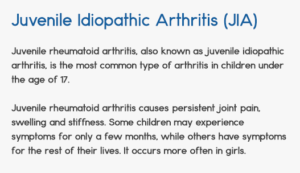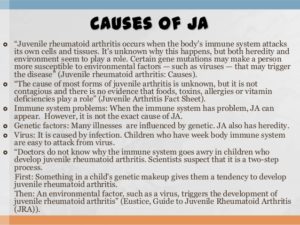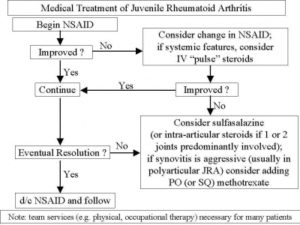Juvenile arthritis (JA) is not a disease in itself. Also known as pediatric rheumatic disease, JA is an umbrella term used to describe the many autoimmune and inflammatory conditions or pediatric rheumatic diseases that can develop in children under the age of 16. Juvenile arthritis affects nearly 300,000 children in the United States.
Although the various types of juvenile arthritis share many common symptoms, like pain, joint swelling, redness and warmth, each type of JA is distinct and has its own special concerns and symptoms
Types of Juvenile Arthritis
- Juvenile idiopathic arthritis (JIA). Considered the most common form of arthritis, JIA includes six subtypes: oligoarthritis, polyarthritis, systemic, enthesitis-related, juvenile psoriatic arthritis or undifferentiated.
- Juvenile dermatomyositis. An inflammatory disease, juvenile dermatomyositis causes muscle weakness and a skin rash on the eyelids and knuckles.
- Juvenile lupus. Lupus is an autoimmune disease. The most common form is systemic lupus erythematosus, or SLE. Lupus can affect the joints, skin, kidneys, blood and other areas of the body.
- Juvenile scleroderma. Scleroderma, which literally means “hard skin,” describes a group of conditions that causes the skin to tighten and harden.
- Kawasaki disease. This disease causes blood-vessel inflammation that can lead to heart complications.
- Mixed connective tissue disease. This disease may include features of arthritis, lupus dermatomyositis and scleroderma, and is associated with very high levels of a particular antinuclear antibody called anti-RNP.
- Fibromyalgia. This chronic pain syndrome is an arthritis-related condition, which can cause stiffness and aching, along with fatigue, disrupted sleep and other symptoms. More common in girls, fibromyalgia is seldom diagnosed before puberty. No known cause has been pinpointed for most forms of juvenile arthritis, nor is there evidence to suggest that toxins, foods or allergies cause children to develop JA. Some research points toward a genetic predisposition to juvenile arthritis, which means the combination of genes a child receives from his or her parents may cause the onset of JA when triggered by other factors.pain or stiffness when moving joints Swelling in the jointsUnfortunately it is not a simple one or two tests to diagnose. The diagnostic process can be long and detailed. There is no single blood test that confirms any type of JA. In children, the key to diagnosis is a careful physical exam, along with a thorough medical history.
How Juvenile Arthritis is diagnosed:
- In the morning or after resting Warm or tender joints Limited range of motion (your child’s ability to move his or her joints)
- Juvenile Arthritis symptoms:
- Causes of these arthritis illnesses:
What is Juvenile Arthritis Treatment?
Unfortunately, there is no cure for juvenile arthritis, although with early diagnosis and aggressive treatment, remission is possible. The goal of treatment is to relieve inflammation, control pain and improve the child’s quality of life. Most treatment plans involve a combination of medication, physical activity, eye care and healthy eating.
Juvenile Arthritis Self Care
An important part of JA treatment is teaching the child the importance of how to follow the treatment prescribed by the healthcare team. Self care also involves helping the child address the emotional and social effects of the disease. Self management encompasses the choices made each day to live well and stay healthy and happy.


